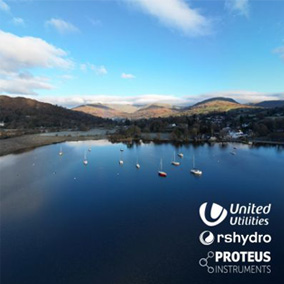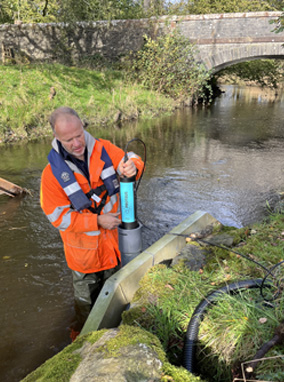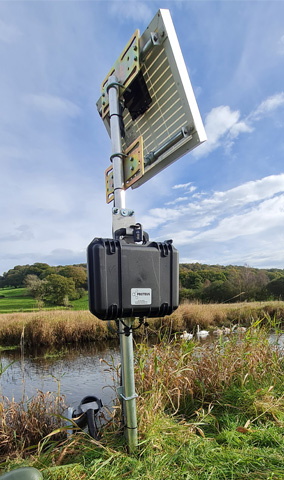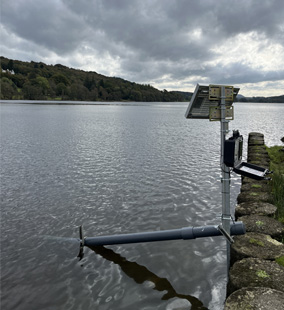Esthwaite Water & Cunsey Beck Water Quality Monitoring

Abstract
Esthwaite Water, known as Beatrix Potter's favourite lake, is a stunning 280-acre private water located in a glacial valley between Lake Winderemere and Coniston Water. Esthwaite Water itself has historically suffered from high phosphate concentrations which have been associated with fish farm activities and a wastewater treatment plan serving the town of Hawkshead, to the north of the lake. The exact sources are not known, United Utilities contacted RS Hydro to install a network of Proteus multiparameter sondes and IoT telemetry systems to monitor nutrient dynamics in and out of Esthwaite Water. The main outflow of Esthwaite Warer flows south to Lake Windermere taking in the discharge of Far Sawry Wastewater Treatment Works.
The network of sensors will allow United Utilities and various stakeholders to understand the water quality of the lake and its outflow into Lake Windermere but more importantly to create a plan with stakeholders to help improve the water quality.

The multiparameter sondes from Proteus Instruments provide game-changing abilities to monitor nutrients that could only previously be measured by using expensive kiosk-based analysers. The sensors have been equipped with turbidity, dissolved oxygen, pH, ORP, conductivity, tryptophan, CDOM, Chlorophyll-A, ammonium/ammonia, E. coli, total coliforms, enterococci, faecal coliforms, and temperature. In addition, the instruments will be used to examine whether they can be used as a surrogate for phosphorous measurement. It is hoped that the Proteus sensors will be able to provide a holistic overview of water quality for the lake and Cunsey Beck.
Once the sources of nutrient input can be pinpointed, a plan will be developed to mitigate their impact.
Ed Sandys, from the Graythwaite Estate that owns Esthwaite Water said, "We are delighted to host United Utilities on Esthwaite Water and Cunsey Beck for the purposes of monitoring and recording data. We all have a responsibility to clean up our rivers and lakes and this is a positive step in the right direction."
Sion Platts-Kilburn, Catchment Manager at United Utilities, said "There are a range of factors that can affect water quality, including wastewater and land run-off, and these new devices will give us a level of insight that we've never had before. Only by working together can we build a picture of what's going on along the entire lake and river, so we are really pleased to be working with Graythwaite Estate team. We are looking forward to sharing the data more broadly."
As Ed Sandys has stated, we all have a responsibility to ensure our environment is clean and safe. This does in fact need everyone to be involved whether it's an awareness of our impacts on the environment or indeed an awareness of the limitations of our wastewater network, we can all help. Disposing wet wipes down the toilet has been cited by many as a simple but avoidable issue. By monitoring various parts of Esthwaite Water and Cunsey Beck we will be able to create a baseline of data to recognise any changes in water quality and indeed focus on how they come to being.

Phosphorous, which is associated with agricultural fertilisers and sewage, when introduced into aquatic ecosystems acts like a fertiliser for algae. When combined with warmer temperatures, phosphorus (amongst other nutrients) will feed algal blooms. It is these blooms, that not only look unsightly but will deplete much needed dissolved oxygen in the rivers and lakes. When oxygen levels fall below critical levels, fish and invertebrates can die and, in some cases, cause major issues for associated biodiversity and the wider ecosystems above and below the water surface. This is not a situation unique to Esthwaite Water or Windermere but affects nearly all but the most pristine aquatic ecosystems around the world. To reverse any associated damage and make positive decisions for the future, good data is essential. To date, apart from manual sampling there has been very little ability to measure the dynamic nature of water quality in our rivers and lakes. Most technology to date is based on manual/lab sampling or basic water quality sampling involving second-tier water quality parameters such as dissolved oxygen, turbidity, pH, conductivity, and temperature. In some cases, ammonium/ammonia is used but the technology to measure this later parameter is fraught with maintenance and accuracy problems. Almost all manufacturers of ammonium Ion Selective Electrodes (ISEs) have an accuracy of ±2mgl. Given that most rivers and lakes should be below 0.2mgl, these sensors do not provide the accuracy of data that is needed to either inform the public, stakeholders or indeed make reliable decisions upon.
Proteus Instruments recognise the issues associated with ISEs and have developed innovative solutions that can provide more reliable, more accurate and lower maintenance ammonium/ammonia data that can be used to make more informed decisions.
Good data such as Proteus sensors will allow all stakeholders on this project to establish baseline data, the timing of any fluctuations in key parameters including ammonium/ ammonia, E.coli, BOD, COD and TOC. One of the outcomes of the project is for the instrumentation to provide a surrogate of phosphorus levels. Laboratory sampling of the various locations will provide the correlation data needed to establish whether this is possible. If it is achieved, a surrogate phosphorus parameter would not only help these local rivers and lakes but would allow organisations to tackle phosphorus and nutrient pollution worldwide.

It appears that this one project could have very dramatic and far-reaching consequences for nutrient pollution monitoring and control worldwide. This project, in the Lake District could provide the flagship model of water quality monitoring that could transform nutrient water quality monitoring worldwide. The data that has been recorded since the probes were installed in October 2023 has been excellent; there is clear hope that this step change in technology can provide more meaningful water quality monitoring worldwide. This project like the Big Windermere Survey, is just one part of the Love Windermere partnership that is looking at gathering data for the entire Windermere Catchment.
Rob Stevens, MD of RS Hydro, stated "we're enormously privileged to be a part of this project to help United Utilities and various stakeholders within the Windermere catchment to understand and pinpoint the point and diffuse sources of organic pollution. With a Queens Award for Innovation (2022), we know that innovation is key to the future success of water quality monitoring. We know that good data will lead to good decisions and that the pivotal abilities of Proteus sensors will ultimately help one of our iconic water bodies to be restored to its former glory."
